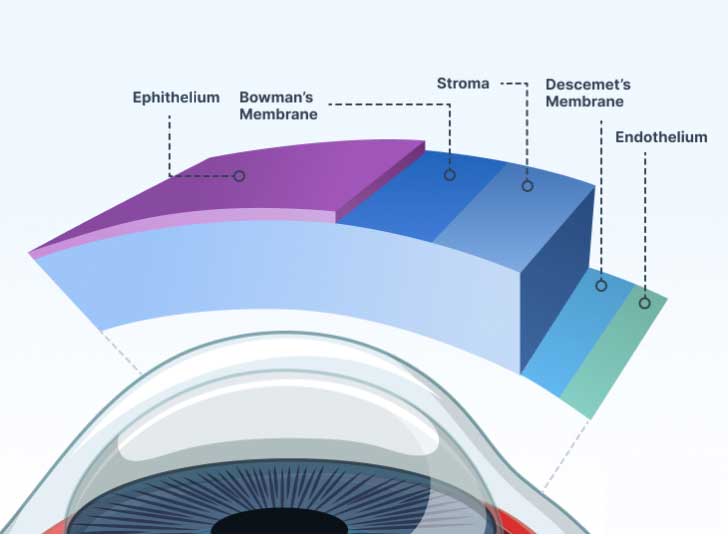
Your cornea must be clear, smooth, and healthy for good vision. If it is scarred, swollen, or damaged, light is not focused properly into the eye. As a result, your vision is blurry or you see glare.
If your cornea cannot be healed or repaired, your ophthalmologist may recommend a corneal transplant.
There are different types of corneal transplants. In some cases, only the front and middle layers of the cornea are replaced. In others, only the inner layer is removed. Sometimes, the entire cornea needs to be replaced.
Eye disease and injuries can damage the cornea. Here are some common eye problems that can lead to a damaged cornea:
Your entire cornea may need to be replaced if both the front and inner corneal layers are damaged. This is called penetrating keratoplasty (PK), or full thickness corneal transplant. Your diseased or damaged cornea is removed. Then the clear donor cornea is sewn into place.
PK has a longer recovery period than other types of corneal transplants. Getting complete vision back after PK may take up to one year or longer.
With a PK, there is a slightly higher risk than with other types of corneal transplants that the cornea will be rejected. This is when the body’s immune system attacks the new cornea tissue. Click to Watch Video
Sometimes the front and middle layers of the cornea are damaged. In this case, only those layers are removed. The endothelial layer, or the thin back layer, is kept in place. This transplant is called deep anterior lamellar keratoplasty (DALK) or partial thickness corneal transplant. DALK is commonly used to treat keratoconus or bulging of the cornea.
Healing time after DALK is shorter than after a full corneal transplant. There is also less risk of having the new cornea rejected.
In some eye conditions, the innermost layer of the cornea called the “endothelium” is damaged. This causes the cornea to swell, affecting your vision. Endothelial keratoplasty is a surgery to replace this layer of the cornea with healthy donor tissue. It is known as a partial transplant since only this inner layer of tissue is replaced.
There are a few types of endothelial keratoplasty. They are known as:
Each type removes damaged cells from an inner layer of the cornea called Descemet’s membrane. The damaged corneal layer is removed through a small incision. Then the new tissue is put in place. Just a few stitches—if any—are needed to close the incision. Much of the cornea is left untouched. This lowers the risk of having the new cornea cells being rejected after surgery.
Your ophthalmologist will talk with you about corneal transplant surgery. You will discuss why you need this surgery, how it can help you see better, and what you can expect during and after surgery.
Once you decide to have a corneal transplant, a date will be chosen for surgery. That date may change if a good donor cornea is not ready for you at that time.
Tell your ophthalmologist about all the medicines you take. They will tell you if you can keep taking them before surgery.
You may need to stop using blood thinners before surgery. You may need to visit your primary care doctor for a physical exam and perhaps other tests. This is to make sure you are healthy enough to have the transplant surgery.
You will not be able to drive after the transplant surgery. You should make arrangements for someone to drive you home after surgery.
A corneal transplant is done as an outpatient procedure.
Here is what will happen just before and during corneal transplant surgery.
The day after your corneal transplant surgery, you will need to go back to your ophthalmologist’s office to have your eyes checked.
The stitches from surgery may or may not need to be removed. This depends on how quickly you heal, the health of your eye, and the type of stitches used.
As you recover from surgery, these are things you need to do to care for your eye:
Call your ophthalmologist if you have concerns or questions about how to care for yourself at home.
Depending on the type of transplant you had and how your eye heals, it can take a year or more to fully recover from this surgery.
Organ rejection is when the body’s immune system sees transplanted tissue as something that shouldn’t be there and tries to get rid of it. Rejection is a problem for up to 3 out of 10 people who have a full thickness transplant (PK). But prompt treatment with steroids can sometimes reverse the rejection and save the transplant. The risk is lower with partial thickness surgeries.
Warning signs of your body trying to reject your cornea transplant include:
Tell your ophthalmologist right away if you have any of these signs. They might be able to stop the rejection with medicine.
Sometimes corneal transplant can cause other eye problems such as:
Even when corneal transplants work as they should, other eye problems could limit the quality of your vision. For instance, the new cornea might not be curved regularly (called astigmatism). Or you could have an eye disease such as macular degeneration, glaucoma, or diabetic retinopathy.
Some people may need more than one corneal transplant. The first transplant could be rejected, or other problems might occur. However, a repeat transplant has a higher rate of rejection than the first one.
If you have a damaged cornea, you and your ophthalmologist will discuss your options for improving your vision. For people with a deeply scarred or swollen cornea, transplant surgery can restore clear vision.